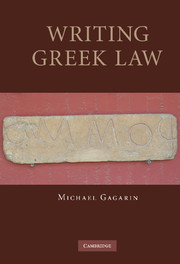Book contents
- Frontmatter
- Contents
- List of illustrations
- Preface and Acknowledgments
- List of abbreviations
- Introduction: Writing Greek Law
- Chapter 1 Law before Writing
- Chapter 2 Writing and Written Laws
- Chapter 3 Why the Greeks Wrote Laws
- Chapter 4 Why Draco Wrote his Homicide Law
- Chapter 5 Oral and Written in Archaic Greek Law
- Chapter 6 Writing Laws in Fifth-Century Gortyn
- Chapter 7 Writing the Gortyn Code
- Chapter 8 Writing Law in Classical Athens
- Chapter 9 Writing Athenian Law: a Comparative Perspective
- Chapter 10 Writing Law in Hellenistic Greece
- Conclusion: Writing Greek Law
- Appendices
- Bibliography
- Index Locorum
- Subject Index
Chapter 7 - Writing the Gortyn Code
Published online by Cambridge University Press: 22 September 2009
- Frontmatter
- Contents
- List of illustrations
- Preface and Acknowledgments
- List of abbreviations
- Introduction: Writing Greek Law
- Chapter 1 Law before Writing
- Chapter 2 Writing and Written Laws
- Chapter 3 Why the Greeks Wrote Laws
- Chapter 4 Why Draco Wrote his Homicide Law
- Chapter 5 Oral and Written in Archaic Greek Law
- Chapter 6 Writing Laws in Fifth-Century Gortyn
- Chapter 7 Writing the Gortyn Code
- Chapter 8 Writing Law in Classical Athens
- Chapter 9 Writing Athenian Law: a Comparative Perspective
- Chapter 10 Writing Law in Hellenistic Greece
- Conclusion: Writing Greek Law
- Appendices
- Bibliography
- Index Locorum
- Subject Index
Summary
If, as I have argued, the frequent use in fifth-century inscriptions at Gortyn of expressions like “as is written” to refer to laws written elsewhere conveyed the sense that the text was part of a larger, interconnected set of legal texts, this sense of a unified set of laws may have been part of the inspiration for one of the grandest legislative achievements of ancient Greece, the Gortyn Code (GC), sometimes called the “Queen of Inscriptions” (Willetts 1967: vii). The scale of GC puts it in a class of its own. In eleven and a half columns of text, with 621 lines and more than 3,000 words, it presents rules on a range of subjects, primarily related to family and property law, but also concerning many other issues. The large clear letters are generally well preserved and with few exceptions, the text is easy to read.
Many interesting questions have arisen about the nature of this extraordinary inscription: Why were these particular laws inscribed together? Is it properly called a code? How are the laws on GC related to those on other inscriptions at Gortyn? Are all these laws the work of a single magistrate? The work of a succession or group of magistrates? Or decisions of some assembly or group of citizens? Or are they verdicts rendered in court cases? I do not expect to answer all these questions, and most of them will never be answered with certainty.
- Type
- Chapter
- Information
- Writing Greek Law , pp. 145 - 175Publisher: Cambridge University PressPrint publication year: 2008

